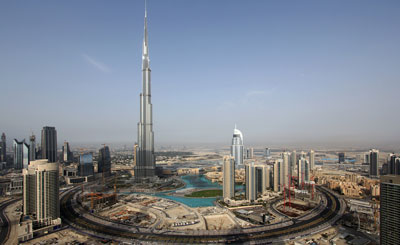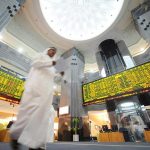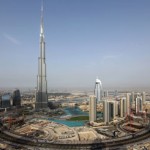Hedge-Fund Boutiques Show Dubai Nurturing Oasis Trading: Cities

When Ahmad Zuaiter started a frontier-markets hedge fund, the former Soros Fund Management LLC money manager chose Dubai over New York and London.
Zuaiter’s Jadara Capital Partners LP and VY Capital Management Co. Ltd. opened in the emirate in the past year, bringing to three the number of hedge-fund firms in the Dubai International Financial Centre, according to Dechert LLP, a law firm that helped establish both companies in the sheikhdom.
“If you want to run a boutique model, the best way is to be located in a centrally positioned hub like Dubai and use it as a nexus to travel extensively and frequently to your target markets,” Zuaiter, 46, said in an interview in his office, close to celebrity chef Marco Pierre White’s Wheeler’s of St James’s restaurant.
Attracting finance professionals like Zuaiter, who moved from Manhattan in 2012, is critical to the health of Dubai’s services-oriented economy. Lacking the oil and gas of neighboring Abu Dhabi, Dubai racked up $129 billion of debt transforming itself into a tourism hub and the Middle East base for banks such as HSBC Holdings Plc (HSBA) and Deutsche Bank AG. Its airport is set to pass London Heathrow as the world’s busiest.
Sheikh Mohammed Bin Rashid Al Maktoum’s family has ruled the emirate — about the size of Los Angeles — since the 1830s. His plans include building the world’s biggest shopping mall, with a theater district modeled on New York’s Broadway, along with five theme parks and a Ferris wheel almost twice the height of the London Eye as the emirate shakes off near default in 2009, when it required a bailout from the United Arab Emirates central bank as well as Abu Dhabi.
Islamic Capital
He set a three-year timetable in October for the former pearl-trading hub to become what he called the capital of the Islamic economy, against competition from Riyadh in Saudi Arabia, Doha in Qatar and Abu Dhabi, all of which are developing financial centers.
Dubai is the leading financial center in the Middle East after climbing eight places to 21 in an interim ranking published last month by London-based consulting firm Z/Yen. The emirate was four positions ahead of Abu Dhabi on an index led by New York and London. Qatar and Riyadh were 31st and 34th respectively in the ranking sponsored by the Qatar Financial Centre.
While financial-services firms looking to set up in the Gulf region probably will choose Dubai, the emirate may struggle to widen its appeal, said Philippe Dauba-Pantanacce, a senior economist for the Middle East at Standard Chartered Plc in London.
Established Hubs
“Dubai is a niche market,” he said. “On a global competition basis, we know it is difficult to undo the ecosystem created over decades by established hubs,” he said.
For Dubai to rival London as a finance and hedge-fund capital, it must overcome concerns about political instability in the region and 50 degree Celsius (122 degrees Fahrenheit) temperatures that drive residents to seek refuge in Geneva and other European cities during the summer. Still, zero tax, office rents one-third the price of London’s West End and an airport that connects with 90 percent of frontier markets make it attractive to startups, Zuaiter said.
A graduate of Georgetown University in Washington, D.C. and Harvard University in Cambridge, Massachusetts, he managed a frontier-markets fund during a six-year stint at Soros in New York and Istanbul. At Jadara, he’ll focus on stocks related to frontier markets such as Pakistan, Morocco, Iraq and the U.A.E. rather than larger emerging markets such as China, he said.
Frontier Markets
Thirty-three countries — including Vietnam, Saudi Arabia, Nigeria and Kenya — are classified as frontier markets by New York-based MSCI Inc., whose indexes are used to measure performance by money managers with an estimated $8 trillion of assets.
Gulf-based airlines such as Emirates and Etihad Airways PJSC are adding routes to Brazil and Russia and destinations in Africa and Asia. Dubai’s main airport attracted 2 million more passengers than Heathrow in the first quarter, with only work on its runways likely to stop it becoming the busiest international crossroads this year. It’s also building a new airport to triple capacity.
The transport links are key to growth in financial services, which accounted for more than 12 percent of gross domestic product in 2013, according to Essa Kazim, the finance center’s chairman. The number of employees in the development, which hosts offices of 22 of the world’s 30 biggest banks, rose 11 percent to about 15,600 last year, DIFC figures show.
The second largest of seven sheikhdoms in the U.A.E., Dubai is a haven for people fleeing turmoil in countries from Tunisia and Egypt to Syria. Only 10 percent of the city’s 2.1 million inhabitants are Emiratis, with hundreds of thousands of migrant workers from South Asia living in labor camps with their passports held by their employers.
Tourism Boom
For those who get to keep their travel documents — a function of their contract, compensation and employer — the emirate has the highest quality of living in the Middle East and Africa, according to a February study by Mercer, a New York-based consulting company. Still, it trailed 72 of the 223 cities surveyed, including top-ranked Vienna and Zurich.
Dubai, with a beachfront that includes the sail-shaped Burj al Arab resort, was ranked the second-most important retail destination after London, Los Angeles-based property company CBRE Group Inc. said in May. The number of tourists increased 11 percent to 11 million last year, official figures show.
Economic growth is set to average 4.6 percent a year between 2012 and 2015, more than twice the rate of the previous four years, according to government forecasts. Real-estate prices increased 35 percent last year, the biggest jump globally, according to Knight Frank LLP.
Office Rents
Still, office rents remain competitive, with Dubai having the world’s 23rd highest-priced space at the end of the first quarter, according to a CBRE survey last month. The emirate’s $92.56 per square foot per year compared with $277 for London’s West End.
While local hedge funds should be able to raise money from institutional investors in the region, the challenge is to build a “critical mass” of managers and assets, said Anthony Lawler, a London-based portfolio manager at Switzerland’s GAM Holding, which has about $129 billion under management.
“Investment managers want to generally be around other smart-money investors and so they tend to largely co-locate where that network already is in place, like New York, London and Hong Kong,” said Lawler, who travels to Dubai several times a year to meet clients. “DIFC does not yet have that critical-mass network to create a self-reinforcing positive cycle in asset management.”
Building Assets
The DIFC, set up by the government in 2004, has lured about 150 money managers with assets of $12 billion, according to the center’s chief executive officer, Jeff Singer. That’s dwarfed by the $470 billion of hedge-fund assets managed from the U.K.
There are signs that Dubai may be able to close the gap. Young British professionals rated the emirate as their top overseas-relocation destination after Hong Kong. The survey last month by Zurich-based deVere Group found that 23 percent of 365 professionals under the age of 35 rated Dubai as their No. 1 choice, trailing Hong Kong’s 26 percent, but ahead of New York, Cape Town and Sydney.
Zuaiter, who started his first fund in May, said his six-person team, includes hires from McKinsey & Co., Morgan Stanley, Abraaj Capital Holdings Ltd. and Franklin Templeton. He declined to provide a target for assets under management.
“You’re now able to hire high quality investment professionals that are anchored in Dubai and the U.A.E.,” said Zuaiter. “The more sophisticated institutional investors that set up, the better it is for the overall ecosystem.”
Source: bloomberg




























